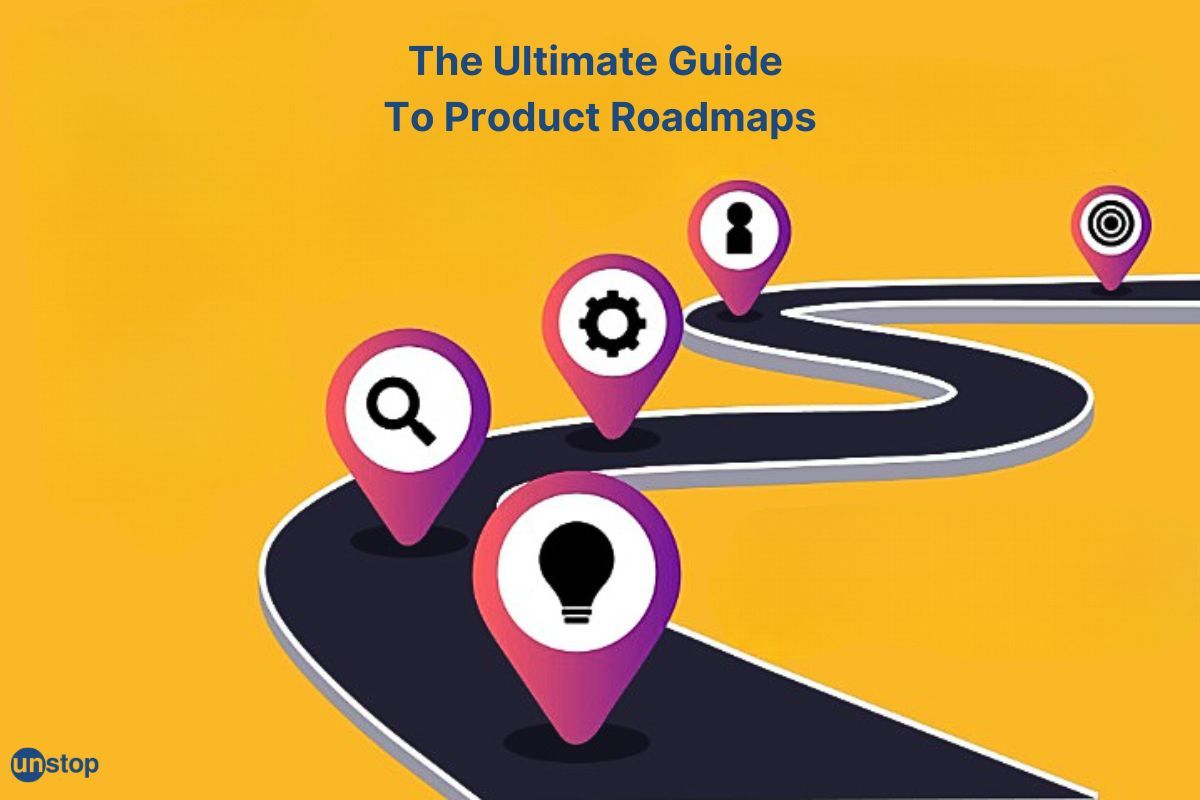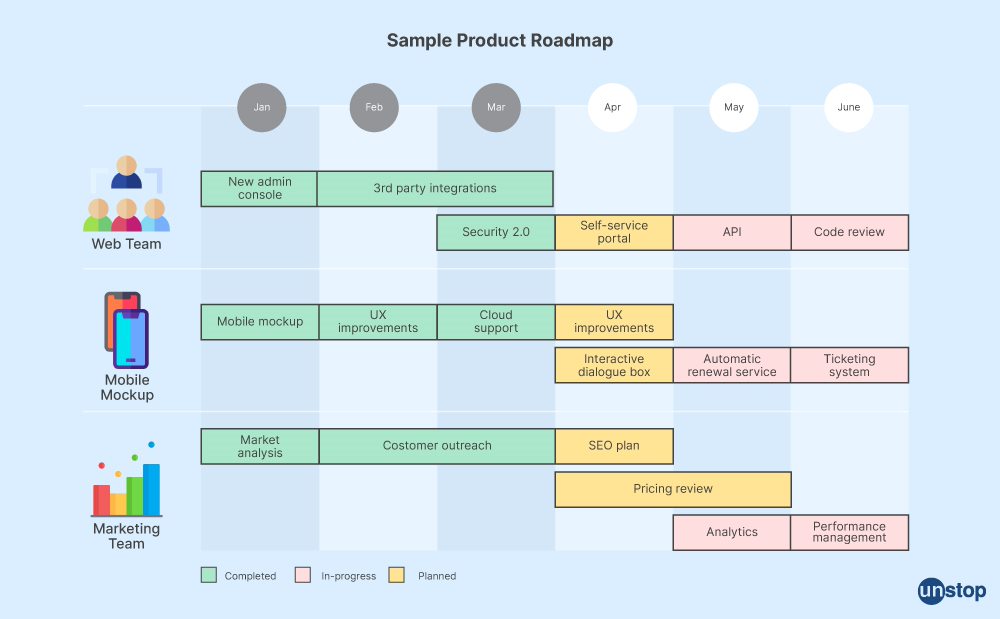- Product Roadmap: What Is It?
- Product Roadmap: Types
- Product Roadmap: Who's Responsible For It?
- Product Roadmap: Why Is It Important?
- Product Roadmap: How To Create It?
- Product Roadmap: Best Practices
- Product Roadmap: Frequently Asked Questions
Product Roadmap: A Complete Guide To It, From Creation To Best Practices

From following the sun and stars to following Google Maps, humans have always relied on a navigation system. Then why should the products they make be any different? This is why we have product roadmaps, the navigation system for a product or service.
Yes, a product roadmap is a way to visualize the path of product development and navigate the stages of product development efficiently. Roadmaps support outcome-based planning and are a common tool used in most organizations. A key piece in the product development process, they're also one of the core areas of responsibility for a product manager.
However, from a market roadmap to a release roadmap, organizations today have strategic roadmaps for multiple activities and not just product development. And a roadmap tool has become synonymous with production management, especially in large-scale organizations.
But the question still remains, what exactly is a product roadmap?
Product Roadmap: What Is It?
As the term goes, product roadmaps are visual tools that show the path or product strategy for taking a product from ideation to execution. It's a communication tool that provides a strategic direction for product development, outlining the high-level goals for a product over time. It's usually developed by product managers.
The primary goal of a product roadmap is showcasing the strategic objective i.e. the why and how of a product (or service), to the different product teams as well as the key stakeholders.
Though roadmaps are most common in product management, they may be utilized and developed by other teams as well. A sales team could have a roadmap for achieving sales targets or a marketing team may develop a roadmap for a particular marketing campaign. The larger the organization, the greater the likelihood of multiple roadmaps, either supporting a common business goal or a common product.
A product roadmap offers a high-level product strategy and will likely include the following information:
i) The strategic goals at each stage of product development
ii) The final deliverables for each stage
iii) The time frame or timelines for each deliverable
iv) Metrics to measure success at each stage
v) Space to incorporate changes, if any
An important thing to keep in mind is that a product roadmap has to be a dynamic document with space to incorporate major changes and revise the product backlog. This doesn't mean that a product roadmap is constantly tweaked but that it has space for updates that may take place due to unavoidable changes.
Take a look at a sample roadmap:

Product Roadmap: Types
Just like there exist multiple types of products and solutions, there are multiple types of product roadmaps. In fact, an organization can have different roadmap types for different teams, solutions, or business goals.
Listed below are some common types of product roadmaps and the primary needs they address:
Who're we developing for? Roadmaps based on end users, i.e., internal and external stakeholders.
These types of roadmaps are audience-based and keep the end user in mind. They're broadly categorized as external and internal roadmaps. For example, for a new app, an internal roadmap for internal stakeholders like the tech or engineering team will have far more technical details (product design broken down into each stage of development) than an external roadmap created for investors (which may showcase only the timeline of each feature on the app and its importance).
Why are we developing? Roadmaps dependent on product goals
This type of product roadmap focus on specific product goals. It's also considered similar to the theme-based type of roadmap. This type answers the why for product development. For example, new features are being introduced on an existing app to increase customer engagement. The product goal or end goal here is increased customer engagement. A roadmap that's built keeping in mind this end goal is a goal or theme-oriented roadmap type.
What are we developing? Roadmaps dependent on product strategy or features
Another type of roadmap is the one where the overall focus is on the features of a product or service. In this case, the stakeholders are not always aware of the reason behind the development of a product or service. It's better to draw a strategy-based roadmap than a feature-based one in this case. A strategy roadmap is beneficial in communicating the product vision. However, a feature roadmap is short-lived and can be difficult to maintain as features may continue to change. But, a feature roadmap can be created to support the main strategy roadmap. For example, creating a tech roadmap for the engineering team, outlining just the tech requirements. In this case, a sales team may not be aware of why these requirements are important - but they can refer to it along with a strategic roadmap to better understand the new product.
Organizations may have other, different types of roadmaps, and product managers may even come up with their own product roadmap template. However, every roadmap needs to be approved by the leadership and take into account the requirements and challenges of the core development team.
Product Roadmap: Who's Responsible For It?
The task of developing a product roadmap mostly falls on product managers or the product management team, but product roadmap creation is actually a group activity.
While product managers may be the ones actually drafting the roadmap, they need to be able to understand the team capacity, constraints, and challenges of each team involved in the process. This is also why, during the product roadmap planning phase, product managers may draft a quick outline and run it past product owners or team managers to take their feedback.
Throughout the product lifecycle, teams may refer to the roadmap and, in some cases, may request changes. The responsibility for updating the product roadmap most likely falls on the product management team, though exceptions may occur. Ultimately, a product roadmap is a plan of action highlighting the evolution of a product over time.
Product Roadmap: Why Is It Important?
A product roadmap is extremely important for any organization and can have the biggest impact on determining a product's success. Here's a look at some of the biggest benefits of having a roadmap:
- First and foremost, it translates your product vision into visual, achievable steps or well-defined product plans.
- Secondly, it allows internal teams and different product owners to get on the same page and work towards a common goal.
- Product roadmapping improves accountability and efficiency. Each team involved in the product development process has clarity on the product plans for their team, along with metrics of success.
- It also improves coordination and collaboration between different product owners. Teams that are aware of each other's goals, deliverables, and timelines (or key dates) may actually find it easier to coordinate.
- Lastly, roadmapping helps align product plans with business objectives.
Product Roadmap: How To Create It?
There may not be a standardized roadmapping process across organizations, or even teams/departments. However, there are certain key steps that one can follow to create a compelling roadmap:
Establish product vision
The first step in building successful products is knowing their ultimate use. Thus, it's important to have clarity on the ultimate goal, or vision for a product. To do this, product managers need to be aware of the market trends, take customer feedback, and understand the problem they're aiming to solve. It's also important for product managers to ensure that a product vision aligns with the business goals.
Create a product strategy
This is where the product vision starts getting translated into high-level strategies. Simply put, this is when product managers start defining the customer value proposition and market positioning, adjust for constraints, evaluate team capacity, and set up strategic goals for each team involved in the process, among other activities. At this stage, product managers need to follow a prioritization process and define manageable objectives and realistic time frames for the teams involved.
Define roadmap audience
This is an important step in building a roadmap. As mentioned above, different roadmaps can be created for different audiences. Thus, it's imperative to understand who the target audience is, even for the roadmap. For example, if a roadmap is being created to present to the customers, it may include product details that offer customer benefits rather than technical details that would interest the development team. Roadmaps, in this instance, can be used to evoke excitement before the actual product hits the market.
Finalize roadmap format
Another key element in designing the roadmap is finalizing its format. Product managers can use product roadmap tools to create a roadmap, but they still need to make decisions about the template. For example, taking a decision about whether the roadmap should be goal-oriented or feature-based, or whether the goals need to be broken down by quarters or months (depending on the expected product launch, level of work required, etc.).
Choose the metrics
It's one thing to set the strategic goals. But it's also important that those goals are satisfactorily met. This means a product roadmap should include well-defined metrics for success. For example, if a goal is gathering user feedback, then a range should be specified for the number of user stories that collectively make for adequate feedback. It's important that these metrics holistically measure the performance of teams i.e., take into account the time, effort, quality, etc. of deliverables.
Room for updates
A good product roadmap should always be flexible enough to incorporate changes, if any. Not every future complication, challenge or trend can be anticipated. The need for new product features, a certain viral trend, or a sudden change in market conditions - anything and everything can impact your product vision or strategy. Thus, it's important that product roadmaps are dynamic in nature and allow room for changes and updates.

Product Roadmap: Best Practices
Yes, there's no standard product roadmap. It can change depending on the business goal, the size of the organization, the team responsible, the end user, etc. However, there are certain best practices that one can follow while creating a roadmap:
- Don't add unnecessary details: A roadmap is a strategic initiative. Thus, it need not list down every minute detail about every step but may only include information pertinent to the audience. Product managers may have to make multiple prioritization decisions here to decide what's important enough to be included. For example, the development team does not need to know in-depth marketing plans but should have an idea about the expected date of product launch and the release plan.
- Keep it aligned with business goals: It's important that the short-term deliverables listed on the roadmap align with the long-term goals of an organization. And the teams working on these goals are well aware of how they're contributing to the overall company vision and goals.
- Regular review: Roadmaps must be reviewed regularly so that adjustments can be made when plans change. Herein also, product managers may participate in prioritization exercises to narrow down the problems that can be solved timely and with available resources.
- Regular communication with stakeholders: A product roadmap may be created by product managers but involves multiple stakeholders. It's important that all stakeholders regularly check the roadmap, communicate with each other and provide feedback. Regular touchpoints with product managers are critical for product success.
Product roadmaps are integral to a product's success. Also, it's a common misconception that product roadmaps are only employed for new products or solutions. Product roadmaps also exist for mature products. Such roadmaps may focus on ways to improve a finished product or enhance its customer integration. At times, organizations may also develop a roadmap for removing a product from the market.
Product Roadmap: Frequently Asked Questions
Here's a look at some of the most frequently asked questions about product roadmaps and their answers:
Q. What's the key difference between a good and bad product roadmap?
A. The main difference between a good and bad roadmap is how well it balances short-term targets with long-term goals and how accurate it is. An outdated roadmap that does not take into account recent changes is serving no one. Similarly, a roadmap that fails to define how product vision can be achieved through a series of short-term goals is failing its purpose.
Q. Can only product managers create a product roadmap?
Yes, the product management team drives roadmap creation. But product roadmap is a collaborative process. In other words, product managers are the ones creating the product roadmap - but only after taking input from different stakeholders. Moreover, in certain cases, other team managers may also develop a product roadmap or take on the role of a product manager for a specific product, solution, or campaign.
Q. How do we know what to add to a product roadmap?
Product managers need to prioritize what can be added to a roadmap and what needs to be cut. Many managers follow a prioritization process or develop a prioritization matrix for it. This allows them to analyze all items and pick the ones that have the highest ROI. It's crucial to remember that a single roadmap can't incorporate every stakeholder's opinion. Nor is it supposed to. This is why a good product manager is one who can strategize and practically decide what elements make it to the roadmap.
Q. How often should a product roadmap be updated?
While there is no fixed time frame, it's important that product managers meet with key stakeholders regularly to discuss progress, give feedback and get information on any major changes. On the basis of this discussion, a product roadmap can be updated only if required. Usually, such meetings take place monthly or quarterly. However, an update to the product roadmap may not be required after every meeting. It's important to remember that just because roadmaps are crafted keeping flexibility in mind does not mean they're updated at will. Doing so will result in constant revisions to the timelines and deliverables and may significantly impact the product release.
Thus, a product roadmap may be updated after feedback from all concerned teams, but not too frequently.
Q. Is a product roadmap the same as a product backlog?
No. A product backlog refers to a list of tasks for the development team. These tasks are prioritized and derived from the requirements of goals listed on the roadmap. A product backlog displays the most important items first, ensuring the team is aware of what to deliver first. However, a product backlog is not a product roadmap. The latter lists high-level goals for all teams, not just the development team.
Suggested Reads:
- What Is Product Management: Its History, Scope & Essential Skills
- Product Management Roles & Responsibilities: Here's What A Product Manager Actually Does
- NIRF Rankings 2023: IIT Madras Tops Overall, Beats IIT Delhi Again
- What Is Mentorship & Why It's Important For Both, Mentors & Mentees
- IIM Bangalore Summer Placements 2024: 539 Offers, Max Recruitment In Management Consulting
I’m a reader first and a writer second, constantly diving into the world of content. If I’m not writing or reading, I like watching movies and dreaming of a life by the beach.
Login to continue reading
And access exclusive content, personalized recommendations, and career-boosting opportunities.
Subscribe
to our newsletter
















Comments
Add comment